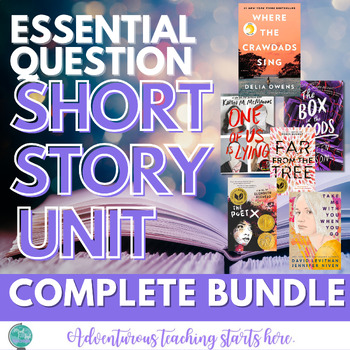Short Story Unit Bundle: Essential Questions & Skills for Critical Thinking
- Google Drive™ folder

What educators are saying
Products in this Bundle (3)
Also included in
- When there's simply not enough time to get creative or write new curriculum for your middle and high school English classes, having a resource to turn to for these things is invaluable. This bundle grants to access to the entire ELA resource library from the Mud and Ink Teaching Store. Over 140+ rPrice $645.00Original Price $885.00Save $240.00
Description
A FRESH APPROACH TO TEACHING THE SHORT STORY:
If you’ve been teaching the same three short stories from the dusty anthology in the corner of your classroom for the last several years, this resource is going to take you in an entirely new direction. This unit is extremely unique in its approach in a few different ways:
- Widening the definition of “short story”
- In order to offer a wide variety of stories without having to purchase and read through countless anthologies, this unit harnesses the power of novel excerpts. Each of the suggested short stories within this unit are actually excerpts or short, individual chapters from contemporary YA and adult fiction & nonfiction. The craft is beautiful to examine, the pieces are high interest and engaging, and best of all, they’re available for free online.
- Inclusive protagonists, stories, and authors
- Each suggested novel excerpt in this unit provides a wide and welcoming lens into the human experience. Because the unit is written with flexibility and a focus on skills, the list of short stories used with the unit is flexible and can include classics or favorite short stories in addition to what the resource provides.
- Anchored in an Essential Question and Aligned Skills
- So many teachers struggle with short story units feeling disjointed or too lethargic in their pacing. By connecting stories through the thread of the EQ, engagement soars as students see a purpose in each story throughout the unit. The unit also sticks closely to practicing the same skills repeatedly rather than spreading dozens of skills across many stories. These units each zero in on a few analysis skills in particular.
UNIT TABLE OF CONTENTS:
- Skills and Standards Alignment: This document discusses and provides a detailed explanation of the standards and skills covered by the activities in the unit.
- Suggested Pacing Calendar: Two different pacing options are provided with a video walkthrough explanation.
- Text Selections: Each of the novel excerpts that have been selected for this unit are provided with direct links (copy and paste into Text Handout Template). Each story has a summary, EQ talking points, and skill practice talking points.
- Anchor Tool: This is the core assignment of the unit. During and after each short story, students will complete this graphic organizer as they focus on the different ways that authors uses the designated skills of the unit.
- Text Handout Template: This is where you can copy and paste each short story so that the formatting stays consistent. Annotation guidelines are provided here.
- Formative Assessment Template: This is the writing prompt that students can respond to as you collect formative data on their progress. A rubric is included.
- Summative Assessment Template: Two possible summative evaluations are provided: a timed writing and a one-pager. Rubrics and explanations are provided.
- Gateway Lesson: This lesson plan is designed to introduce the EQ with students and hook them into the curiosity and excitement of the unit ahead.
This unit will leave you and your students feeling empowered and energized. With a concentrated focus on literary analysis of setting and conflict paired alongside true inquiry-driven conversations on each essential question, you’ll finally feel like your short story unit has made a lasting impact on your students for the long term.
You might also be interested in these other resources from Mud and Ink Teaching:
- Choose Your Own Adventure - Narrative Writing
- The Best Part of Me - A Creative Photography Lesson
- Reading Activities for Book Clubs & Lit Circles
Don't forget that leaving feedback earns you points toward FREE TPT purchases, so let me know how everything is working out!
© Mud and Ink Teaching Please note - this resource is for use by one teacher only. Additional teachers must purchase their own licenses. If you are interested in purchasing several licenses, please let me know. Good luck on your adventurous teaching journey!
mudandinktpt@gmail.com
Let's Stay Connected!






